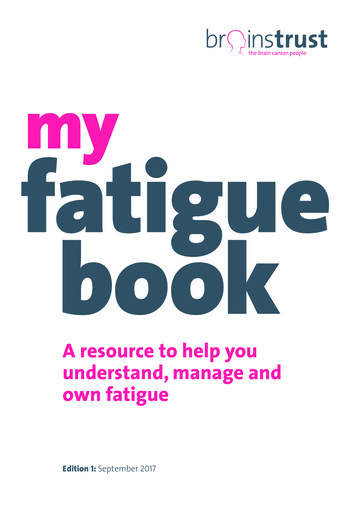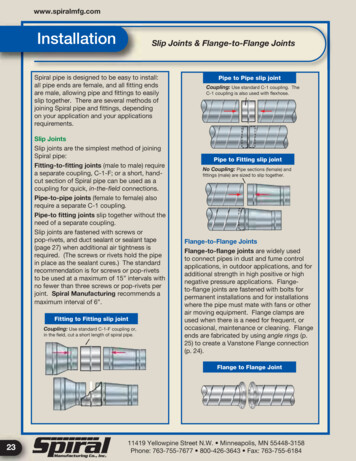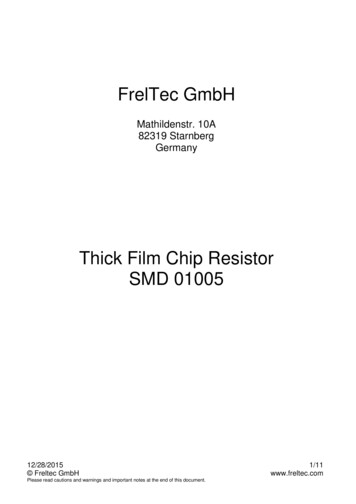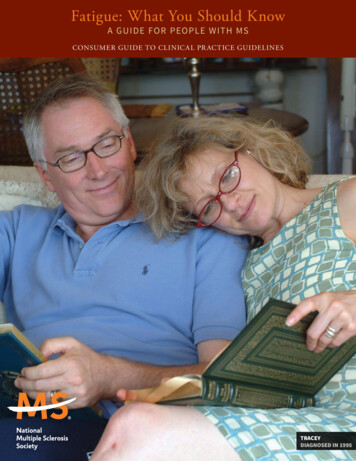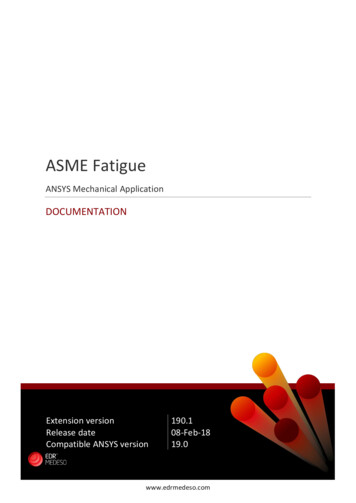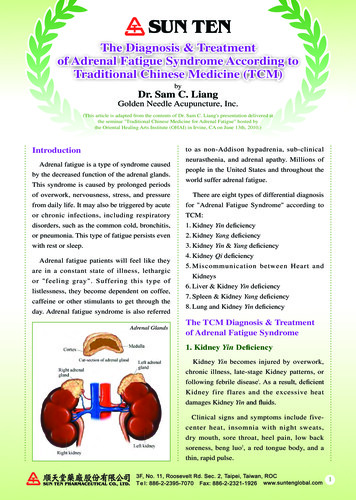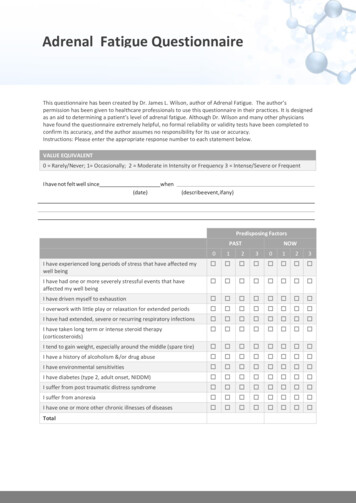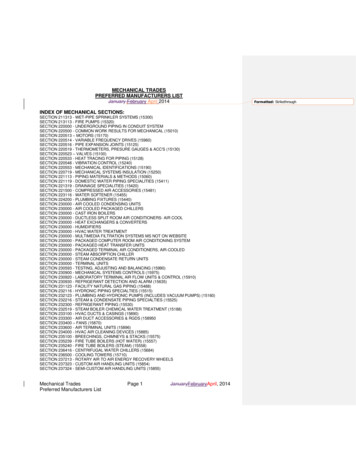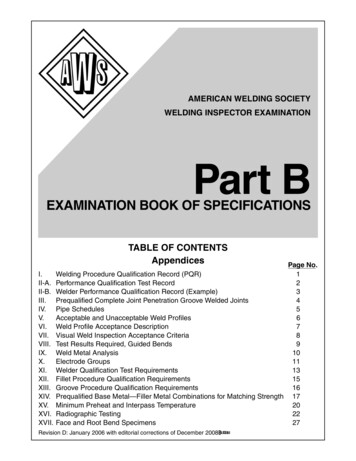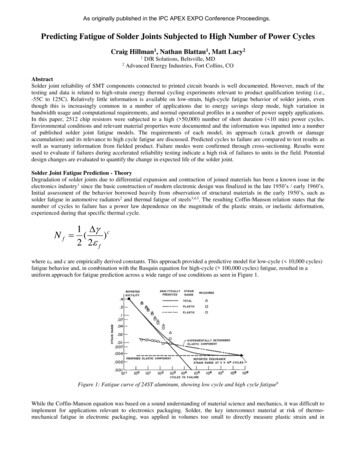
Transcription
As originally published in the IPC APEX EXPO Conference Proceedings.Predicting Fatigue of Solder Joints Subjected to High Number of Power CyclesCraig Hillman1, Nathan Blattau1, Matt Lacy221DfR Solutions, Beltsville, MDAdvanced Energy Industries, Fort Collins, COAbstractSolder joint reliability of SMT components connected to printed circuit boards is well documented. However, much of thetesting and data is related to high-strain energy thermal cycling experiments relevant to product qualification testing (i.e.,-55C to 125C). Relatively little information is available on low-strain, high-cycle fatigue behavior of solder joints, eventhough this is increasingly common in a number of applications due to energy savings sleep mode, high variation inbandwidth usage and computational requirements, and normal operational profiles in a number of power supply applications.In this paper, 2512 chip resistors were subjected to a high ( 50,000) number of short duration ( 10 min) power cycles.Environmental conditions and relevant material properties were documented and the information was inputted into a numberof published solder joint fatigue models. The requirements of each model, its approach (crack growth or damageaccumulation) and its relevance to high cycle fatigue are discussed. Predicted cycles to failure are compared to test results aswell as warranty information from fielded product. Failure modes were confirmed through cross-sectioning. Results wereused to evaluate if failures during accelerated reliability testing indicate a high risk of failures to units in the field. Potentialdesign changes are evaluated to quantify the change in expected life of the solder joint.Solder Joint Fatigue Prediction - TheoryDegradation of solder joints due to differential expansion and contraction of joined materials has been a known issue in theelectronics industry1 since the basic construction of modern electronic design was finalized in the late 1950’s / early 1960’s.Initial assessment of the behavior borrowed heavily from observation of structural materials in the early 1950’s, such assolder fatigue in automotive radiators2 and thermal fatigue of steels3,4,5. The resulting Coffin-Manson relation states that thenumber of cycles to failure has a power law dependence on the magnitude of the plastic strain, or inelastic deformation,experienced during that specific thermal cycle.1 cNf ()2 2 fwhere f, and c are empirically derived constants. This approach provided a predictive model for low-cycle ( 10,000 cycles)fatigue behavior and, in combination with the Basquin equation for high-cycle ( 100,000 cycles) fatigue, resulted in auniform approach for fatigue prediction across a wide range of use conditions as seen in Figure 1.Figure 1: Fatigue curve of 24ST aluminum, showing low cycle and high cycle fatigue6While the Coffin-Manson equation was based on a sound understanding of material science and mechanics, it was difficult toimplement for applications relevant to electronics packaging. Solder, the key interconnect material at risk of thermomechanical fatigue in electronic packaging, was applied in volumes too small to directly measure plastic strain and in
geometries too complicated to solve through simple mechanics models (Coffin and Manson’s original papers used flat plategeometries as an example).Norris and Landzberg7 attempted to address these deficiencies by proposing that plastic strain dominated thermo-mechanicalfatigue of eutectic SnPb alloy, the primary solder of choice in electronic packaging at that time. In ignoring the influence ofelastic strain, Norris-Landzberg were able to draw a direct relationship between change in temperature and plastic strain. Toaccount for the influence of creep-driven plasticity, a mechanism of less concern for high temperature steels, NorrisLandzberg added additional correction factors based on cyclic frequency (which is directly related to dwell times) andmaximum temperature.This approach to predicting solder joint lifetime under thermal cycling was widely embraced by the electronics community,to the extent that the Norris-Landzberg equation is the only technique referenced in the relevant JEDEC qualificationdocuments, JESD478 and JESD949.The Norris-Landzberg equation, while eminently practical, has several key limitations. The most critical is the inability tomake a fatigue prediction without test data. This effectively eliminates the use of Norris-Landzberg from any designactivities. The equation is also based on the assumption that creep behavior is driven exclusively by temperature and time,whereas there is a critical applied stress element. Depending upon the packaging architecture, the change in applied stress atdifferent thermal cycles could have a more substantive effect then identified through frequency and temperature, possiblychanging rate constants depending on the solder joint configuration and overall packaging architecture 10. Finally, the equationis dependent upon the plastic strain being driven by the same mechanism in both environments. As demonstrated bydeformation maps (Figure 2), different atomic-level mechanisms can be triggered to induce plasticity and creep behaviorsdepending on the specific combination of temperature and applied stress. The limitation of this approach has been made mostobvious by the inability to develop a Norris-Landzberg equivalent for Pb-free solders (SAC305)11,12.Figure 2: A representative schematic of a deformation map showing the various mechanisms that can induce damage duringcyclic fatigueFurther improvement to the prediction of solder fatigue was provided by Engelmaier 13, who returned back to the principles ofCoffin Manson, but used solid mechanics models more relevant to the solder joint geometry and low-cycle fatigue data forSnPb solder14. To determine the plastic strain, or strain range, Engelmaier assumed that the in-plane (shear) steady-statestrains dominated low-cycle fatigue behavior. This allowed for the use of a distance-to-neutral model, where
with C being a geometry-dependent constant (1/ 2 for leadless ceramic chip carriers), LD is the diagonal distance from theneutral point (assumes a square/rectangle shape), is the difference in thermal expansion between the die/component andsubstrate/printed board, and T is the thermal cycle. Engelmaier then derived f and c through curve fitting of the Wild data,with f 0.325 andc (-0.442) – (6x10-4 Ts) (1.74x10-2)[ln (1 f)]where Ts is the average temperature during the thermal cycle and f is the frequency of the thermal cycle.In some respects, the Engelmaier model was even more successful than the Norris-Landzberg. Like Norris-Landzberg, theinputs required to use the Engelmaier model was available to the practicing engineer. It was also widely adopted in theindustry, primarily through IPC SM-78515. The Engelmaier model overcame some of the limitations of the Norris-Landzbergmodel, including a strong link to the original Coffin-Manson methodology, ability to predict fatigue performance withouttesting, consideration of the package geometry, and a basis on experimental fatigue results.The Engelmaier approach, while superior to previous attempts to predict low-cycle solder fatigue both in accuracy andpracticality, had some limitations. One of the flaws of the Engelmaier approach lies with the Wild data that is the basis of itsfatigue exponent. Wild performed isothermal mechanical fatigue experiments at 25C and 100C at between 4 and 300 cyclesper hour. These temperature ranges are above room temperature and therefore provide limited insight into fatigue behavior atcolder temperatures where creep-based mechanisms are reduced and plasticity-driven mechanisms play a larger role infatigue behavior. The cyclic frequency is higher than most thermal cycling test conditions, which are typically one (1) to two(2) per hour, and far higher than field conditions, which can require several hours to go through a thermal cycle. This has theeffect of minimizing the time-dependency of creep mechanisms and the resulting damage evolution. This tendency tooverestimate and underestimate creep effects may have contributed to the accuracy of the predictions.An additional challenge to both Coffin-Manson and the derived Engelmaier model was their assumption that the plastic strainwas constant over the entire temperature cycle. Work by Hall 16 measured a hysteresis loop, where the stress-strainrelationship could vary dramatically as the solder joint was exposed to a range of temperatures (see Figure 3). It is importantto note that the nominal shape of hysteresis loops can be more uniform, depending upon the applied stress, temperature, anddwell time. The cycle measured by Hall induced failure in less than 500 cycles, which is typically too low to be accuratelypredicted through analytical means).Figure 3: Hysteresis loop of a leadless ceramic chip carrier solder joint during thermal cycling between -25 C and 125 C16(obtained through http://www.msed.nist.gov/solder/clech/Sn-Pb Creep.htm)Additional experiments also demonstrated a more consistent correlation between strain energy and cycles to failure withfewer dependencies on geometry or load orientation17. These observed behaviors necessitated a move to a strain energy basedprediction scheme. Blattau18 introduced a modification of the Engelmaier model that replaced strain range with strain energy.To compute strain energy, Blattau used a foundation stiffness model to calculate the force being applied to the solder jointbased on displacement equations, where
where LD is the diagonal length (distance to neutral point), E is the elastic modulus, A is the area, h is the thickness, G is theshear modulus, a is the edge length of the bond pad, 1 refers to the component, 2 refers to the board, s refers to the solderjoint, c refers to the bond pad, and b refers to the board. The shear stress can then be computed by dividing the force by theeffective solder joint area.Once the strain range and the shear stress are computed, the strain energy is calculated assuming a hysteresis loop that isroughly equilateral in shape (Figure 4)Figure 4: Representative schematic of a solder joint hysteresis loop19The relationship between cycles to failure and strain energy is then determined based on work performed by Syed 20, whodemonstrated a power law correlation between strain energy and cycles to failure with an exponent of -1. The foundation ofthis behavior is based on first principles of secondary creep behavior. The Blattau approach, which combines the first-orderequations derived from the original Coffin-Manson equation with the observed dependence on strain energy, has beenvalidated for both chip components and ball grid array packaging technology (see Figure 5).Figure 5Solder Joint Prediction – Validation (Power Cycling)Almost all solder prediction models go through a validation process where predictions are compared to experimental results.These validation processes can be a direct comparison of measured time to failure to theoretical predictions or theexperimental results can be correlated to normalized parameters relevant to the model algorithm. Most validation activitiesattempt to provide a correlation over three orders of magnitude, typically between 100 to 10,000 cycles.
Isothermal testing tends to be the dominant vehicle for validation studies. A study by the University of Maryland determinedthat over 82% of the test conditions reported in the IEEE literature were isothermal thermal cycles 21. This is true even thoughone of the initial concerns regarding solder joint fatigue was the performance of devices subjected to power cycling. Themajority of publications on solder fatigue under power cycling focus on the die attach structure common within high powerinsulated gate bipolar transistors (IGBT)22,23. This specific structure does not necessarily lend itself to common surface mount(SMT) solder joints due to the highly constrained layer architecture and the inability to directly monitor or define die attachfailure.The limited studies on power cycling of standard surface mount devices have primarily focused on correlation to isothermalcycling or shock. An earlier paper by Popps et. al.24 showed a 50% increase in lifetime with power cycling, even though thepower cycle had a longer dwell time (15 minutes vs. 5 minutes) and a faster ramp rate (60C/min vs. 20C/min). A similarincrease in number of cycles to failure was predicted and observed by Li et. al. 25; they assigned this difference in behavior tothe large thermal gradient across the ball grid array package, which effectively increased the CTE of the BGA under the dieshadow while limiting the degree of expansion over the diagonal length.The limiting factor of these papers and other investigations on power cycling of SMT packages is that the time is typicallyless than 10,000 cycles. While this cycle count could be considered as the outer bound of low cycle fatigue (others believeplastic strain is dominant out to 100,000 cycles), it fails to consider that an increasing number of applications are expected tohave tens of thousands of power cycles in the actual field application. Enterprise applications are increasingly poweringdown, either to sleep mode or turned off, to save energy. To conserve battery charge, consumer mobile devices (smartphones, tablets, and laptops) can experience between 10 to 50 power cycles per day for three (3) to five (5) years, which canresult in a total of 15,000 to 90,000 power cycles over its lifetime. A similar environmental profile is starting to ramp up inautomotive applications, where start-stop technology can introduce a power down 12 times for every four (4) miles driven.With the average urban driving of 25 miles per day, this works out to 250,000 cycles over ten (10) years.The purpose of this paper is to provide a better understanding of the relevance of standard strain energy based models for lowcycle fatigue of solder joints in predicting the behavior of standard SMT packages subjected to a very high number of powercycles.Experimental ProcedureA RF power supply was subjected to an accelerated life test (ALT). The test conditions for these units are shown below Coolant Temperature:o Inlet Air Temperature: 50 C / Inlet Water Temperature: 45 C Output Power Cycling:o RF ON: 4 min / RF OFF: 1min Output Load:o Two Months at 50 Ohmso Four Months at 31.3 j34.3 (complex load)Three units failed during ALT. Circuit troubleshooting identified the failure sites as 2512 resistors in the gate drive circuit.The last failure initiated after 53,215 Output ON events. Visual examination of the 2515 SMT resistors in the RF Gate Drivecircuit revealed problems with solder joint cracking (see Figure 6).Figure 6: Optical image of failed solder joints at R4 and R5
To obtain a better understanding of the extent of solder joint cracking, all eight resistors in the RF Gate Drive circuit werecross-sectioned and the cross-sectional views are shown in order from R2 thru R9 in Figure 7. Based on the crackpropagation path and the phase coarsening observed around the crack path, it was concluded that the solder joint crackingwas due to low cycle fatigue. A diagram from a typical solder fatigue 26 is shown in Figure 8 with the cross-section of thefailed R5 solder joint. Based on the schematic, the R5 solder joint crack followed a “typical” path starting from the inner end(heel) and propagating until failure occurred.
Figure 7: Cross section views of R2 (top) to R9 (bottom). “Heatsink” end is on the Left.
Figure 8: Typical failure diagram from Lui et. al. and a cross-section of failed R5 solder jointTo better understand the drivers for solder fatigue under the 2512 resistors, T-type thermocouples were placed on the gatedrive resistors (see Figure 9). The temperatures were recorded using a 343970 data logger and a graph of the resistortemperature data for multiple power cycles is shown in Figure 10 and a table of peak temperatures is displayed in Table 1.Figure 9: Thermocouple placement on Gate Drive Resistors
ALT Resistor R2-R9 Temperatures during 4min ON, min OFF Power cycles807570R2R3Temperature (C)R4R565R6R7R860R9Inlet AirExhaust Air5550450:00:000:07:120:14:240:21:360:28:48Time (minutes)0:36:000:43:120:50:240:57:36Figure 10: Thermocouple data for Gate Drive ResistorsTable 1: Table of Temperatures for Gate Drive Resistors (*temperatures seem low; possible measurement issue)ResistorR2*R3R4R5R6R7*R8R96kW Output PowerMax TempMin Temp( C)( 79.356.678.556.8ΔT( C)12.618.319.922.120.616.622.721.60.5kW Output PowerMax TempMin Temp( C)( 71.549.470.449.7ΔT( C)8.815.516.220.319.314.622.120.7Correlation of Failure Behavior to Strain Energy ModelsThe results from thermal measurements and design and material parameters were inputted into the Blattau model andcompared to ALT results. The inputs used for the calculation are shown in Figure 11. The solder joint height (h) of 0.036mmwas determined using a cross-section of a resistor on an unfailed board.
Figure 11: Inputs for the Blattau modelIt can be seen that the cycles to failure prediction provided by the Blattau model (50,614 cycles) is within 5% of the observedtime to failure (53,215 cycles). These results would seem to suggest that plastic strain energy is still a critical driver for solderfatigue under these conditions, even given the short dwell times (4 minutes) and high number of cycles ( 50,000).Additional modeling was performed using a crack propagation proposed by Han and Song 27 specifically for chip resistors,wherewith N crack propagation life, a length of crack, K3 0.0044 (model constant for SnPb), K4 1.3227 (model constant forSnPb), and ΔWave averaged strain energy density change per thermal cycle. This equation ignores crack initiation (region 1)and assumes that the life is dominated by crack propagation (region 2). Thermal data and FEA simulation was used todetermine the range of ΔWave based on the Han and Song model (see Figure 12). ΔWave was determined to be 0.020MPa for asimilar operating profile (5.67 min ON, 1.33 min OFF) to the ALT application. The ALT failures occurred at 50C ambientand an output profile of 4min ON and 1 min OFF, which works out to the equivalent of 0.030MPa. Using this value of strainenergy density and a critical crack length of 1mm, based on the pad length, gives the following:
Figure 12: FEA model and estimate of ΔWaveAssessment of Potential Design ChangesChanges to the circuit design, PCBA layout, materials or operating conditions could be used to improve the robustness of the2512 resistor solder joints under ALT. The Blattau model, due to its higher accuracy, was used to evaluate how particulardesign changes would influence the expected lifetime. Table 2 below lists the proposed change and the estimated impact tothe expected life compared to the baseline.Table 2: Proposed change and estimated impact to expected life compared to baseline.
DescriptionBaselineChange to Pb-freesolderChange ResistorPackage to 2010 from2512Lower AmbientTemperature from50 C to 25 CIncrease Pad Widthfrom 3.2 to 3.5RF Output Powerreduced from 6kW to0.5kWCommentALT conditionsPb-free solderperforms better withlow strain energysmaller solder jointCTFPad L x W AmbientOutputEstimate Solder Package (mm)( C)RF ON/OFF Time Power50,614 63Sn37Pb 2512 1.28 x 3.2504min ON, 1min OFF 6kW279,520 SAC305 2512 1.28 x 3.2504min ON, 1min OFF 6kW71,430 63Sn37Pb20101.28 x 2.5504min ON, 1min OFF6kWmore like customeroperating temperature68,727 63Sn37Pb25121.28 x 3.2254min ON, 1min OFF6kWslightly more cycles forcrack to propigateshows ΔT dependence53,622 63Sn37Pb25121.28 x 3.5504min ON, 1min OFF6kW66,260 63Sn37Pb25121.28 x 3.2504min ON, 1min OFF 0.5kWConclusionsA strain energy based first order model is capable of relatively accurate prediction out to 50,000 power cycles with dwelltimes less than 5 minutes. This would suggest that plastic strain and creep continue to play a critical role in solder jointfatigue even under conditions that would tend to be extended beyond typical low-cycle fatigue.References1WB Green, "A fatigue-free silicon device structure," American Institute of Electrical Engineers, Part I: Communication andElectronics, Transactions of the , vol.80, no.2, pp.186-192, May 19612HE Pattee and RM Evans, “The Performance of Some Soft Solders at Elevated Temperatures and Pressures,” SpecialTechnical Publication 189, ASTM, Philadelphia, PA, 1956, p. 1033LF Coffin, “The Problem of Thermal Stress Fatigue in Austenitic Steels,” Special Technical Publication 165, ASTM, 1954,p. 314LF Coffin, “A study of the Effects of Cyclic Thermal Stresses on a Ductile Metal,” Trans. ASME, 76, 931–950 (August1954).5SS Manson, “Behavior of materials under conditions of thermal stress,” Proceedings of the Heat Transfer Symposium,University of Michigan Engineering Research Institute, Ann Arbor, Mich, pp. 9-75, 1953.6SS Manson, “Discussion”, J. of Basic Engineering / Trans. ASME, p. 537-541, December 19627Norris, K C, and A H Landzberg. “Reliability of Controlled Collapse Interconnections.” IBM Journal of Research andDevelopment 13, no. 3 (1969): 266-2718JESD47I, Stress-Test-Driven Qualification of Integrated Circuits, JEDEC, July 20129JESD94A, Application Specific Qualification Using Knowledge Based Test Methodology, JEDEC, July 2008 (reaffirmedSeptember 2011)10Syed, A., "Limitations of Norris-Landzberg equation and application of damage accumulation based methodology forestimating acceleration factors for Pb free solders," Thermal, Mechanical & Multi-Physics Simulation, and Experiments inMicroelectronics and Microsystems (EuroSimE), 2010 11th International Conference on , vol., no., pp.1,11, 26-28 April 201011Hillman, C., “Assessment of Pb-Free Norris Landzberg Model to JG-PP Test Data” DfR Solutions Presentation, February21, 200612Miremadi, J., Henshall, G., Allen, A., Benedetto, E., Roesch, M., “Lead-Free Solder-Joint-Reliability ModelEnhancement”, IMAPS 200913W. Engelmaier, Fatigue Life of Leadless Chip Carrier Solder Joints During Power Cycling, IEEE Trans. Comp. HybridsManuf. Tech., vol CHMT-6, no. 3, September 1983, p. 232-23714R. N. Wild, “Properties of some low melt fusible solder alloys,” IBM Tech. Rep. No. 712000408, Oct. 197115IPC SM-785 standard, Guidelines for Accelerated Reliability Testing of Surface Mount Solder Attachments.16Hall, P. M., "Strain measurements during thermal chamber cycling on leadless ceramic chip carriers soldered to printedboards", Proceedings, 34th Electronic Components Conference, New Orleans, LA, May 14-16, 1984, pp. 107-11617TS Park and SB Lee, Isothermal Low Cycle Fatigue Tests of Sn/3.5Ag/0.75Cu and 63Sn-37Pb Solder Joints under MixedMode Loading Cases, 52nd Electronic Components and Materials Conference Proceedings, 2002, p. 23p4-s23p9
Blattau, N. and Hillman, C. “An Engelmaier Model for Leadless Ceramic Chip Devices with Pb-free Solder,” IPC/JEDECLead Free Conference, Santa Clara, CA, March 200619Lead Free Solder: Mechanics and Reliability, by John Hock Lye Pang, Theory on Mechanics of Solder Materials chapter 220Syed, A., “Accumulated Creep Strain and Energy Density Based Thermal Fatigue Life Prediction Models for SnAgCuSolder Joints,” ECTC 2004, pp. 737-746 - corrected21M. Osterman, Effect of Temperature Cycling Parameters (Dwell and Mean Temperature) on Durability of Pb-free Solders,IMAPS Winter Technical Symposium, Chesapeake Chapter, January 201022O'Keefe, M.; Vlahinos, A., "Impacts of cooling technology on solder fatigue for power modules in electric traction drivevehicles," Vehicle Power and Propulsion Conference, 2009. VPPC '09. IEEE , vol., no., pp.1182,1188, 7-10 Sept. 200923Herrmann, T.; Feller, M.; Lutz, J.; Bayerer, R.; Licht, T., "Power cycling induced failure mechanisms in solder layers,"Power Electronics and Applications, 2007 European Conference on , vol., no., pp.1,7, 2-5 Sept. 200724D. E. Hodges Popp et al., “Flip chip PBGA solder joint reliability: Power cycling versus thermal cycling”, Flip ChipTechnology Workshop and Exhibition, IMAPS, January 200325Jue Li; Karppinen, J.; Laurila, T.; Kivilahti, J.K., "Reliability of Lead-Free Solder Interconnections in Thermal and PowerCycling Tests," Components and Packaging Technologies, IEEE Transactions on , vol.32, no.2, pp.302,308, June 200926D.R. Liu and Yi-Hsin Pao, Fatigue-creep crack propagation path in solder joints under thermal cycling, Journal ofElectronic Materials, V 26, N 9, 199727Changwoon Han and Byeongsuk Song, “Development of Life Prediction Model for Lead-free Solder at Chip Resistor,”2006 Electronics Packaging Technology Conference.18
Coffin Manson, but used solid mechanics models more relevant to the solder joint geometry and low-cycle fatigue data for SnPb solder. 14. To determine the plastic strain, or strain range, Engelmaier assumed that the in-plane (shear) steady-state strains dominated low-cycle fatigue behavi
